1: Carbohydrate metabolism and integration with cycling performance.
Now that I have scared you, let’s get started. So the first part of understanding the bioenergetics of training and cycling training one must first begin with carbohydrate metabolism. It is an extremely complicated process that I won’t get too far into(that is actually the simplified version above.) It is the most readily used source of fuel in the body. At it’s most basic form, the breakdown of glucose generates ATP and NADH (at different ratios) which can be fed into muscle contraction and the electron transport chain respectively. Carbohydrate is the most available source of energy in the body. As stated, simplest form of carbohydrate is glucose. Glucose is obtained via ingestion of carbohydrate (simple or complex). The difference between a simple or complex carbohydrate is that a complex carbohydrate is formed from multiple units of sugars. So when you attach two glucose molecules together, without getting too much into specifics, you get maltose. To understand its importance is unlocking the key to modern day performance in endurance sport today. Top athletes will consume up to 80-100g of carbohydrate per hour during large metabolic days, Ironman’s, 200mi(320km) gravel races, marathons – you get the idea[1]. If you don’t want to learn about science, theory, and potential health implications of the ingestion _____insert skip to guide below_____
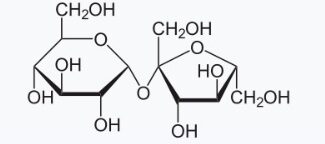
Sucrose(fig 1.) is special in that it remains a disaccharide without forming large chains of carbohydrate. It is formed from glucose and fructose and is broken down by sucrase in the duodenum. Sucrose is not metabolized by salivary amylase. It is relatively inert until the small intestine, unless acted on by Streptococcus mutans in the mouth. If acted on by bacteria in the mouth, there are acidic by-products created and are the basis for tooth decay. Tooth health is especially important if consuming large amounts of sucrose. I would not recommend utilizing sucrose as a fuel source for this reason as tooth enamel, is a limited resource. Once tooth decay has set in, it is permanent. Be sure to check the ingredients of your sports drinks to confirm if they have sucrose containing substrates. Fructose and glucose, produced by sucrase acting on sucrose in the small intestines, are directly absorbed via GLUT transporters into the blood stream from the duodenum[2]. This is important because different transporters use different sugars as substrates. GLUT5 for fructose, and dependent on concentrations of glucose in the intestine SGLT1, GLUT2 [2]. Fructose can then be metabolized into lactate and used as a fuel, or transported to the liver and converted into glucose metabolites to be used in glycolysis.
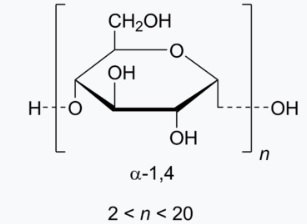
Maltodextrin(fig 2.), cyclic dextrin, maltose, etc. are all polymers of glucose units. Maltose is the simplest of this group, a disaccharide. This is important because digestion of maltose actually begins in the mouth, unlike sucrose. Salivary amylase, which is an alpha amylase, immediately begins digestion in the mouth and breaks it down into it’s constituent glucose molecules. The glucose is then able to diffuse through the gums, and eventually is absorbed within the small intestine. Alpha amylase works on all alpha 1,4 linkages[3]. Pancreatic amylases, which are eventually secreted into the small intestine during digestion, are also alpha amylases digesting the same 1,4 glycosidic linkage. This includes maltodextrin, amylopectin, and maltose etc. Maltodextrin is an important constituent of many sports drinks. Because the eventual metabolism of these carbohydrates into monomers(single sugar units) is dependent on enzyme catalyzed reactions, you can see that there could be variance between athlete to athlete in carbohydrate absorption rates but also show up in various disease states. For example, patients with pancreatic insufficiency have both hormonal insufficiency(inability to respond to varying concentrations of glucose in the blood stream appropriately, leading to type 3c diabetes mellitus) and digestive insufficiency(inability to process carbohydrates and fats inappropriately, leading to foul smelling, oily stools). Conversely, a top athlete may demonstrate the ability to absorb the 100g of CHO an hour to maintain high performance in endurance sport.
Glucose, or dextrose, is a monomer(single unit). Dextrose digestion begins immediately within the mouth, as there is partial absorption within the gums. Glucose and its metabolites are utilized in multiple metabolic pathways including, glycolysis(the breakdown of glucose), glycogenesis(the synthesis of glycogen), the Pentose-Phosphate-Pathway(generation of NADPH to create different biomolecules), etc. * Without getting into too much detail, glucose is extremely important. As you can see in Fig A and the wikipedia links above, things get very convoluted as far as sugar processing goes! The important thing is that large ingestion of carbohydrate will preserve intramuscular and hepatic glycogen. This has to do with the interplay of insulin and glucagon. Insulin, which is produced from beta cells within your pancreas is a hormone that responds to high sugar levels within the blood to drive glucose into the cells. When glucose gets pushed into the cells, if glucose levels are high there are anabolic processes that are turned on. This includes fat, protein, and glycogen synthesis. This very important because 2 hours into a 5 hour race you do not want to be catabolic. It is also important because if you want to become stronger, these anabolic signals need to be turned on. Glucagon, produced by alpha cells from your pancreas, is produced in response to low blood sugar levels. When your pancreas senses low blood sugars, there is a response in cortisol and glucagon. Cortisol is responsible for the jitteriness and sweatiness, increases blood sugar but also leads to insulin insensitivity. Glucagon works on multiple catabolic processes in conjunction with cortisol to raise your blood sugar. These include fat, protein, and glycogen breakdown. This is not desirable in someone attempting to make gains in fitness!
Glycogen is the predominant storage of glucose within the body. The body contains approximately 300-700g of glycogen, which is dependent on various factors, including muscle mass, presence of liver disease, and nutritional state. I attempt to describe the importance of glycogen on my own, but the most amazing paper on the metabolism of glycogen and high carbohydrate diets was written by Bob Murray and Christine Rosenbloom located here. Preservation
The importance of >60g CHO/hr is emphasized by W. Smith et al. (2010) [7] who found that at 30g CHO/hr and 60g CHO/hr of carbohydrate ingestion, with 12 cyclists riding at 210W during a 20km time trial, endogenous glucose production was decreased. What this implies is that muscle glycogenolysis and hepatic glycogenolysis, as well as gluconeogenesis are all inhibited, which they hypothesize in the paper is likely due to high blood sugar levels leading to higher insulin levels inhibiting these catabolic processes [7]. This has important performance implication, as preservation of glycogen stores will play a role in a late race winning move or pushing past an anaerobic threshold at a decisive moment in a race. As a precaution to fight my own confirmation bias in this subject, a quick google of “carbohydrate does not improve cycling performance” does not yield significant results. I actually found a meta-analysis that analyzed 50 studies(!) and found that 30 to 80g CHO/hr increased time trial performance, time to exertion, and submaximal exercised followed by time to exertion significantly with all p values less than 0.05 and no confidence intervals crossing 1!
This begs the question, how can we manipulate carbohydrate absorption/oxidation rates?
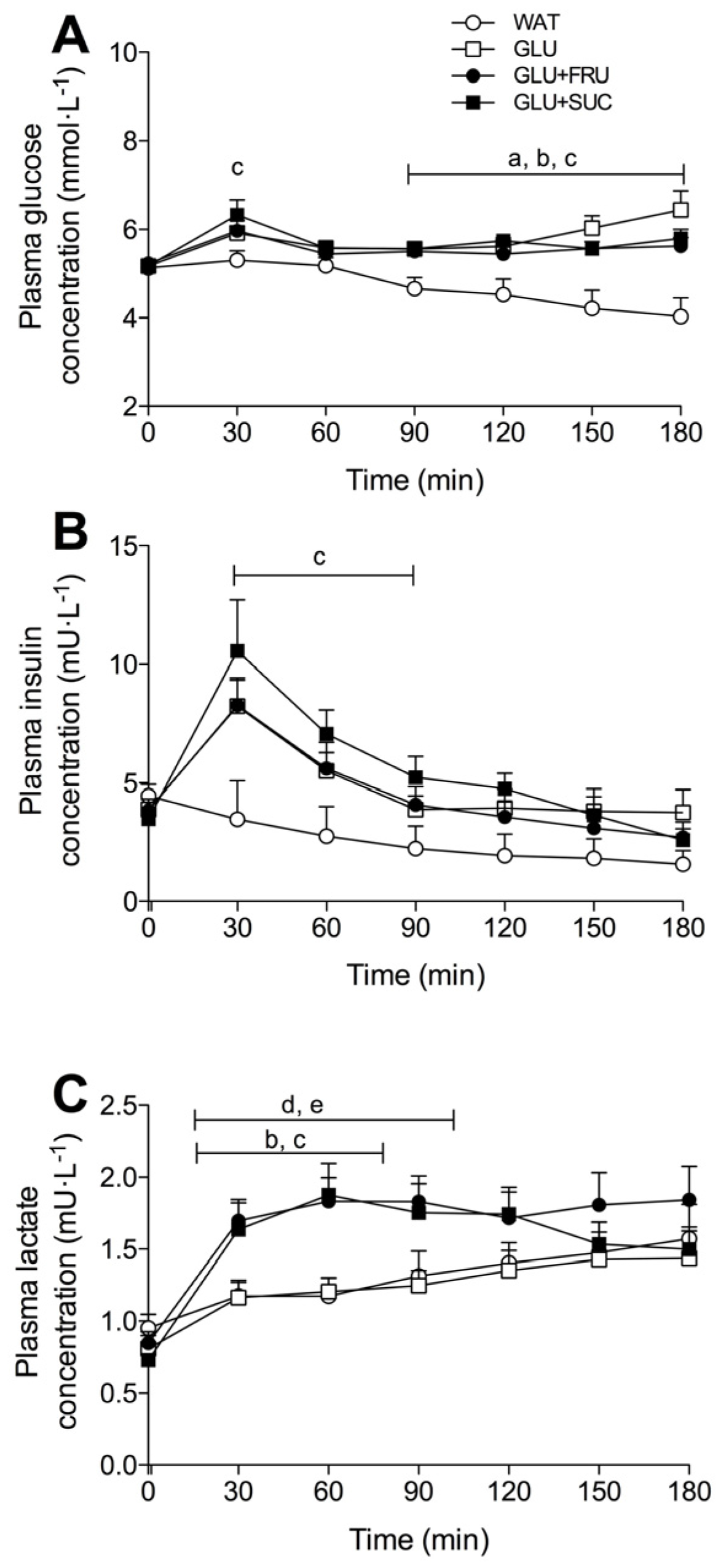
In an incredible study performed by Trommelen et al (2017)[6], they exposed trained cyclists cycling at 50% of Wmax to various solutions containing fructose + glucose, glucose + sucrose, glucose, and water(fig 3.). They radiolabeled the carbon and measured the exhaled C13 in the form of carbon dioxide. What they found is that the athletes who consumed the solutions fructose + glucose and sucrose + glucose had the highest rates of exogenous carbohydrate oxidation[6]. Also you may notice that lactate concentrations rose fairly quickly, potentially putting people past the LT1 threshold (by numerical value, not by empirical value) which, in an athlete that is measuring lactate concentrations during exercise may lead to an erroneous value and the underprescription of training intensity. This is like because a significant proportion of fructose metabolism is towards lactate production and eventual glycolysis byproducts.
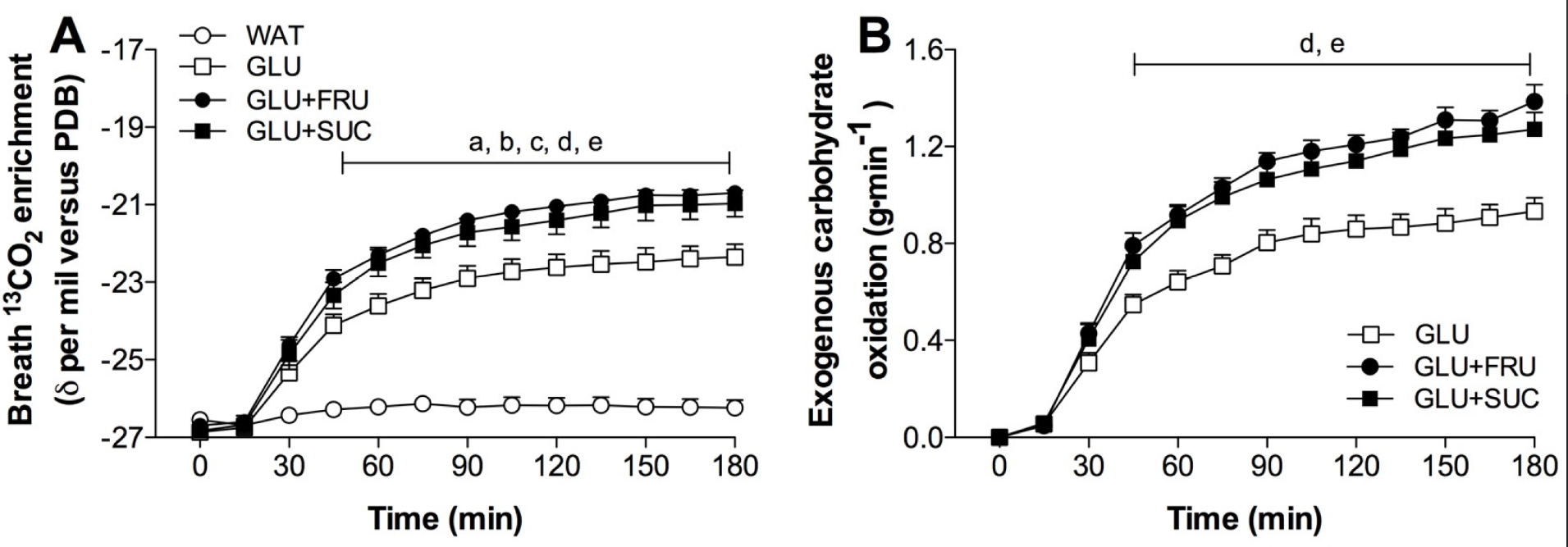
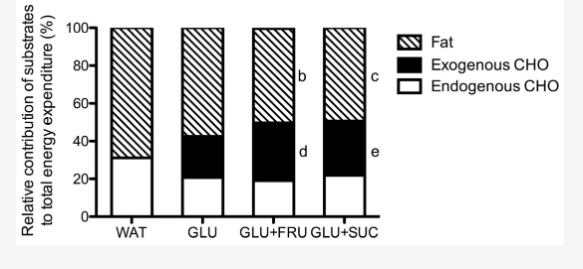
As you can see, in figure 5, in a similar finding to W Smith et al. [7], Tromellen et al. [6] found that endogenous carbohydrate metabolism contributed a smaller relative amount compared to the water control group. The water control group was also able to contribute a majority of the metabolism from fats, however fat metabolism is not sustainable long term. As you see from figure 4, exhibit A glucose concentrations dropped throughout the exercise protocol. This implies a number of physiological processes, including oxidative stress from fatty acid oxidation, increased cortisol production which will in turn lead to catabolism of ketogenic and glucogenic amino acids into ketogenic and glycolytic pathways which could have been utilized for anabolic processes in the post-exercise period, downregulation of insulin, more utilization of muscle and hepatic glycogen. This will eventually lead to a spiral of binge eating post-exercise from the increased stress, increased blood sugars post exercise, increased insulin response, leading to an intense low post-exercise.
A reason why there were improved oxidation rates in the fructose containing group is because of the difference in transporters within the gut. The majority of dextrose absorbed through the small intestine is done so by a SLGT1 and GLUT2 transporters, and fructose via a GLUT5 transporter [2]. Therefore if attempting to achieve peak carbohydrate absorption rates, you must ingest both glucose and fructose. This is because these transporters can become saturated, think of them like a garden hose restricting water.
___________Ideal ratio of glucose-fructose__________________
Hypothetical question: How can we speed up gastric emptying, so that we may process sugars quickly in the small intestine?
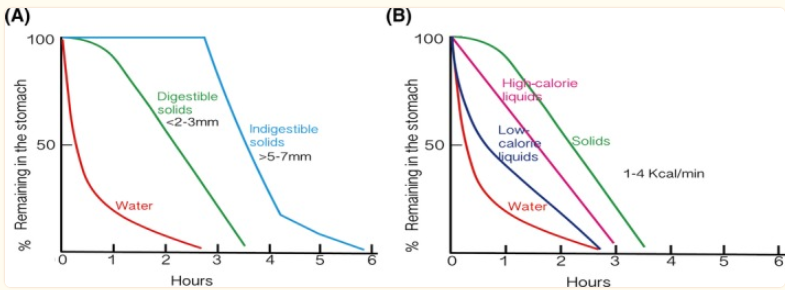
An important thought would be, how to speed up gastric emptying, but not speed up small intestine emptying as to not cause diarrhea. A number of factors slow gastric emptying, including the osmolality(in simple terms, concentration of sugars) in the fluid, exercise intensity(if strenuous exercise blood flow to the gut is restricted and carbohydrate selection should be the simplest possible), fiber content, volume of fluid ingested, and meal temperature. Your selection of gel is important,
As well as small intestinal digestion of carbohydrate, intestinal bacteria are also responsible for the production byproducts of fermentation of indigestible carbohydrates like cellulose. They also help produce vitamins, like vitamin K which is essential in the production of clotting factors II, XII, IX, X protein C, and protein S. Intestinal bacteria also play a part in the enterohepatic circulation of toxins. Indigestible carbohydrate is converted into various short chain fatty acids, alcohols, branched chain fatty acids, amines, sulfur compounds, and indoles. Some of these carbohydrate byproducts, for example short-chain fatty acids, 95% are absorbed by colonocytes and used as energy while 5% are excreted as feces[5]. This is important because the intestines are highly metabolically active, constantly sloughing off enterocytes and colonocytes, excreting and absorbing fluids, propelling fluids via peristalsis(gut moving poo forward) – you get the idea. This implies that the healthier your gut biome and gut, the more the carbohydrate absorbed higher up in the small intestine can be used more readily for high intensity exercise or anabolic processes like glycogenesis.
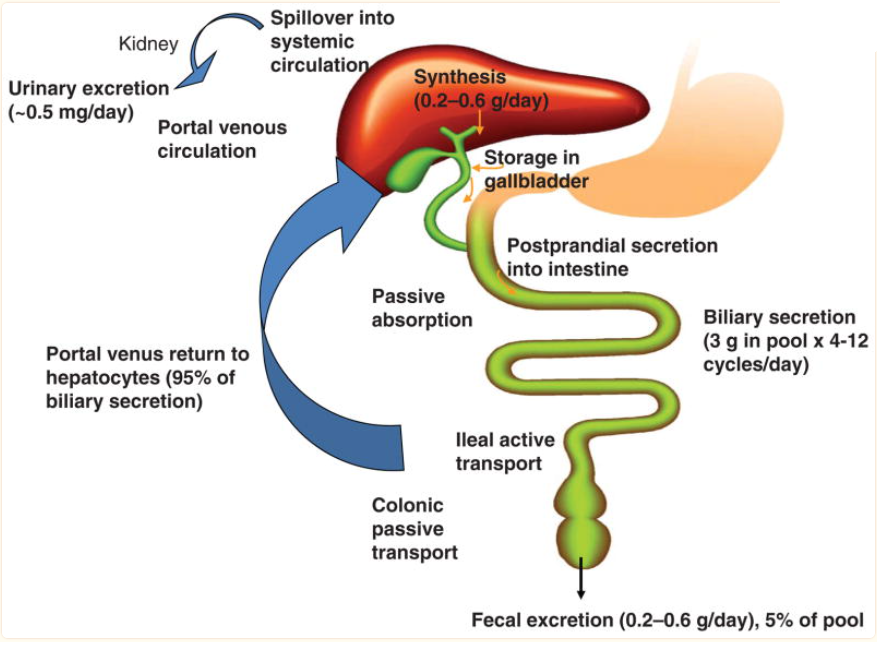
Another important concept is enterohepatic circulation of bile acids (fig 6.), which are utilized in the absorption of dietary fats. A substantial portion of bile, which is secreted from the liver into the small intestine, is reabsorbed within the colon. Bile acids, which are the downstream byproduct of the breakdown of red blood cells(they have a 90 day shelf-life in the body), can have both positive and negative effects. Toxic bile acids, in which the liver plays a significant role in the detoxification of poisons can be reabsorbed through enterohepatic circulation and cause a second wave effect of damage on the liver. Alternatively, other bile acids play a role in stimulating energy metabolism, protecting the liver from inflammation, and improving insulin sensitivity.[8] You could also hypothesize that if your gut health is not ideal, that you could be losing anti-inflammatory bile acids, reducing your vitamin absorption, increasing red blood cell breakdown(via various mechanisms, anemia of inflammation, increased breakdown) and therefore cycling performance would be hindered. This could be why there is a significant amount interest being generated in the gut flora of these high nutrient absorbers.
So all of this raises the question: How do you foster a healthy gut microbiome?
There have been numerous studies without any clear benefit, but given the conceptual framework above we can talk about some foods that may foster an appropriate gut microbiome. Foods that support higher levels of SCFA(short chain fatty acids – as you remember above they are the metabolites from indigestable carbohydrates that reach the gut) appear to be inulin, starches, gums, fructooligosaccharides – prebiotics. Basically lots of whole foods, vegetables, fruits, seeds, legumes. [9] On the extreme, hospital side of things, a fecal transplant(putting someone else’s feces past your stomach into your small intestine) has been utilized in persons with extremely diseased guts, such as in the case of refractory Clostridium difficile infections.
#____________Elaborate on gut bacteria specifically?______________
#____________Elaborate on gut metabolism, maybe?_____________________
So you just told me to ingest 100g CHO/hr while doing high intensity, long duration exercise, and eat a diverse diet at the same time?
Yes.
Here is a guide. I have heard multiple anecdotes, utilized the USAC coaching guide, and used some papers to generate this. Ultimate this should serve as a guide and you should do what is best for you based off trial and error.
Example carbohydrate and nutrient ingestion advice:
A typical energy gel contains 100 calories, assuming complete emptying of a packet (there always seems to be a few grams left in the packet). Typically they can contain 25g of carbohydrate. This is assuming that 1 gram of carbohydrate delivers 4 calories to the normal person. So during high intensity, long duration exercise(greater than 3 hours), carbohydrate ingestion can go as high as 120g CHO/hr or 480 calories/hour. Gel and liquid calories during an endurance event are preferred to solid calories for a multitude of reasons. As exercise intensity goes up, blood flow is diverted from the gut to exercising muscle so less energy is available for digestion. Therefore foods need to be simpler during the high intensity periods.
Pre-hydration 0.3 to 0.5L of water/sport drink 15-30 minutes before exercise if you are fairly well hydrated before the event.
Zone two ride of 2 hrs duration: No carbohydrate load. 25-50g CHO/hr
High intensity ride of 2-3 hours duration: Consider reduced carbohydrate load to replete glycogen stores(5g CHO/kg bodyweight) the day prior, an
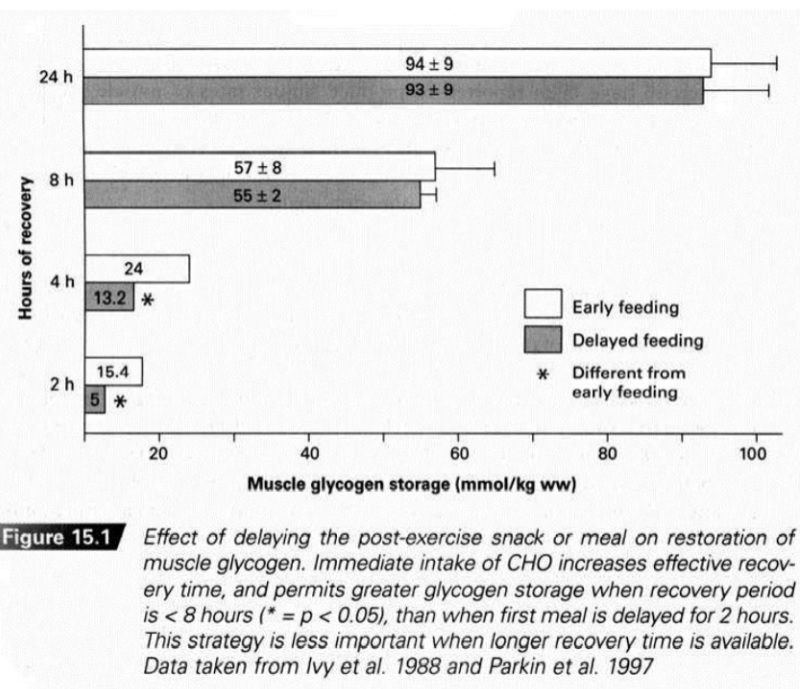
d reduced carbohydrate load 3 hours prior to the event. Maintain 50-75g CHO/hr during the event.
High intensity, endurance event, sustained 200W+: 10g/kg CHO carbohydrate load[cite], 3 to 5 g CHO/kg body weight 3 hours prior to the event[cite]. > 3 hrs duration 75-100g CHO/hr (possibly more if you can train your stomach).
Maintain salt intake from all sources, 400-1000mg of sodium/L of fluid and 120-225mg/L potassium during events greater than 60 minutes in duration. You want to prevent hyponatremia from pure water intake and all the carbohydrate intake. Consider salt tablets if your sports drink does not hit this goal.
Protein recommendation for completeness – 1.0-1.5g/kg bodyweight throughout the day, not during exercise.
Include lots of whole grains, greens, fruits, vegetables, non-processed meats, include prebiotic foods and adequately hydrate as a general nutrition strategy.
Prebiotic/probiotic foods include: kimchi, sauerkraut, kombucha, yogurts.
Immediate ingestion within 2hrs of completion of exercise 1g CHO/kg bodyweight if you need to recover within the next 8hrs for another event. Make sure to hydrate accordingly.
2: Mechanical and chemical efficiency
_____Typical efficiency of male and female cyclists______
______Does crank arm make a difference?______
______ Does femur length make a difference?_____
______How long can we sustain large metabolic days?_____
______Basal metabolic rate resting____
3. Stress and it’s impact on metabolism
_____The effect of cortisol on training and metabolism_____
_____The effect of cortisol on sleep_______
Disclaimer: This is a labor of love. It is subject to change as new evidence comes forward, and as I am challenged by new ideas. Please leave comments below if things are unclear, need explanation, or you need to call me an idiot.
[1]Multiple anecdotal reports.
– Keegan Swenson mentioning eating 120g carbohydrate per hour in gels/liquid calories alone.
Jan Frodeno acheiving 120g/hr on the bike during the Collins Cup.
[2]Koepsell H. Glucose transporters in the small intestine in health and disease. Pflugers Arch. 2020 Sep;472(9):1207-1248. doi: 10.1007/s00424-020-02439-5. Epub 2020 Aug 23. PMID: 32829466; PMCID: PMC7462918.
[3]Janeček Š, Svensson B, MacGregor EA. α-Amylase: an enzyme specificity found in various families of glycoside hydrolases. Cell Mol Life Sci. 2014 Apr;71(7):1149-70. doi: 10.1007/s00018-013-1388-z. Epub 2013 Jun 27. PMID: 23807207.
[4]Gorbach SL. Microbiology of the Gastrointestinal Tract. In: Baron S, editor. Medical Microbiology. 4th edition. Galveston (TX): University of Texas Medical Branch at Galveston; 1996. Chapter 95. Available from: https://www.ncbi.nlm.nih.gov/books/NBK7670/
[5]|Gijs den Besten, Karen van Eunen, Albert K. Groen, Koen Venema, Dirk-Jan Reijngoud, Barbara M. Bakker, VOLUME 54, ISSUE 9, P2325-2340, SEPTEMBER 2013 The role of short-chain fatty acids in the interplay between diet, gut microbiota, and host energy metabolism.
[6]Trommelen J, Fuchs CJ, Beelen M, Lenaerts K, Jeukendrup AE, Cermak NM, Van Loon LJC. Fructose and Sucrose Intake Increase Exogenous Carbohydrate Oxidation during Exercise. Nutrients. 2017; 9(2):167. https://doi.org/10.3390/nu9020167 https://www.mdpi.com/2072-6643/9/2/167
[7]Smith JW, Zachwieja JJ, Péronnet F, et al. Fuel selection and cycling endurance performance with ingestion of [13C]glucose: evidence for a carbohydrate dose response. J Appl Physiol (1985). 2010;108(6):1520-1529. doi:10.1152/japplphysiol.91394.2008
[8]Chiang JY. Bile acid metabolism and signaling. Compr Physiol. 2013 Jul;3(3):1191-212. doi: 10.1002/cphy.c120023. PMID: 23897684; PMCID: PMC4422175.
[9]